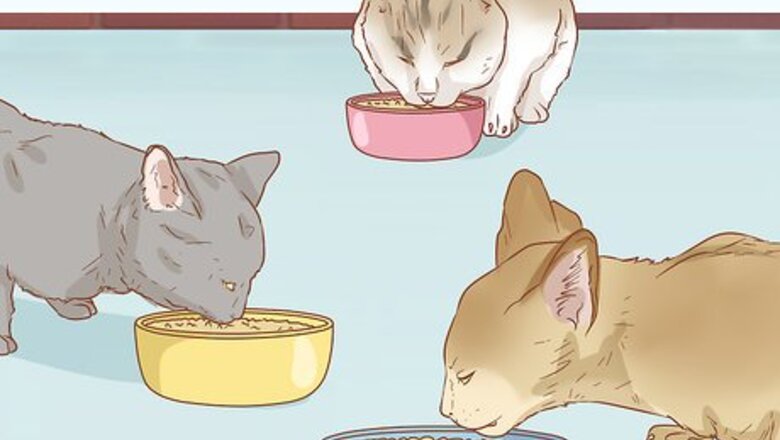
views
Feeding Multiple Cats at Once
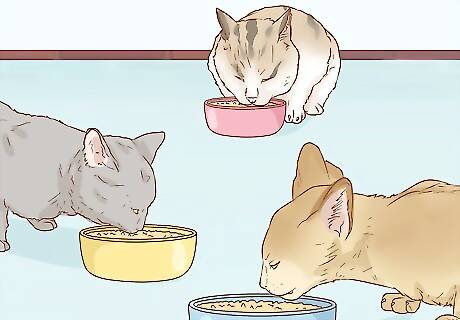
Feed discrete meals. Feeding all of your cats at one time, instead of letting them graze, will minimize conflict and fighting. Instead of allowing access to food at all times, which can lead to conflict when two cats want to eat from the same bowl at the same time, timed meals will allow all cats to have their own space and food to focus on. How often you feed your cats each day depends on your schedule. In many cases, it works best to feed your cats once in the morning before you leave and once again in the evening when you return. Provide food puzzles if you have a cat(s) that is used to grazing instead of eating at meal times. This will help them transition to timed meals. Putting a small amount of kibble in one of these puzzles won't replace a whole meal but it may satiate a cat enough until meal time comes around.
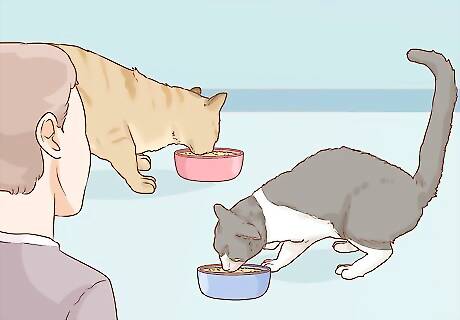
Monitor feeding time. Do not feed your cats and then leave your home. It is important that you monitor feeding time, so that you can make the cats stay at their own feeding stations and break up any conflicts that might occur. It may be that your presence calms your cats while they eat because they know that they will be protected from other cats trying to get their food when you are around. This will allow them to focus on their food more than on defensiveness. If you see a cat trying to eat another cat's food, physically separate them. It's important that you do this so the more submissive cat doesn't get taken advantage of.
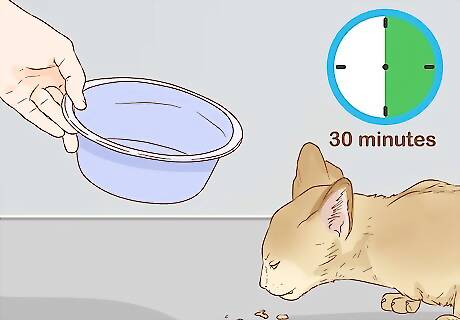
Remove food dishes after 20-30 minutes. When feeding multiple cats you should remove food dishes after the cats have eaten or after 20-30 minutes, if one or more of your cats are very slow about eating. This will teach the cats that there is a set time to eat and if they don't eat at that given time, then there is no food to be had. The goal is to make meal time a time for strictly for eating, not a time to play games, show dominance, or fight for territory. Setting specific meal times and taking away food when meal time is over requires a gradual training process that may take some time for your cats to adjust to. If your cat meows repeatedly at you for food when it is not meal time, just remember that you are working to make a peaceful household and your cat will not starve if it has to wait an hour for food.
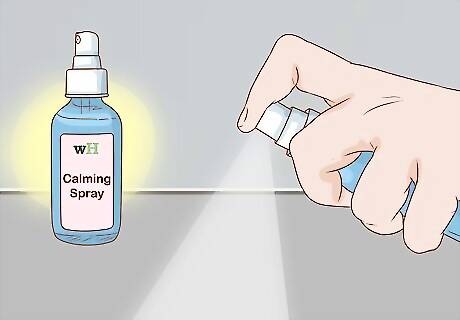
Use calming sprays. If your cats are very territorial and tend to fight over food, you may want to try using a calming product made for cats during feeding times. These products tend to be non-toxic sprays that use pheromones to calm cats and reduce fear and aggression. Spray one of these products, which are usually available at most pet stores, around the feeding area or on the specific cats that are most fearful or aggressive. The pheromone sprays used for calming cats mimic the pheromones given off by mother cats to calm their kittens.
Setting Up Separate Feeding Stations
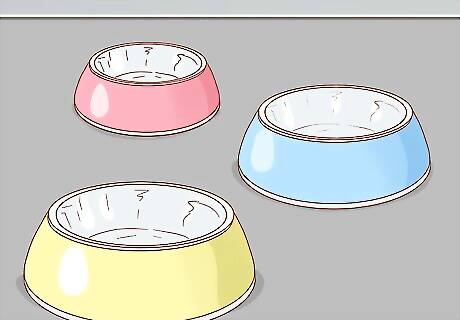
Give each cat its own dish. When feeding multiple cats, competition can be fierce if every cat doesn't have its own dish to eat from. Separate dishes allow each cat to have their own space and their own food to focus on, instead of focusing on defending against another cat. Make sure that the food bowls are as identical as possible. You do not want to create competition for a food dish that is easier to eat out of or is slightly bigger. Don't forget to place a water bowl near each food bowl. In most cases, when you first set out multiple food dishes the cats will naturally gravitate to one of their own. Once they have basically picked their bowls, make them stick to them to establish their territories.
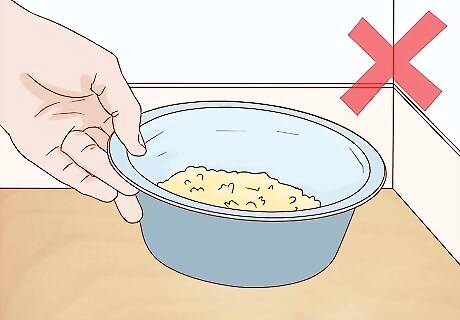
Don't place food dishes against walls. In many cases, a cat in a multi-cat household will want to be in a position while eating where it can see any other cats coming towards it. If you place food dishes against a wall, the cat will naturally be forced to have its back to the wall. This may add to its anxiety and not allow it to relax during eating. Placing your cat's bowl even a foot away from the wall should allow it to sit in any place around the bowl that it feels is best.
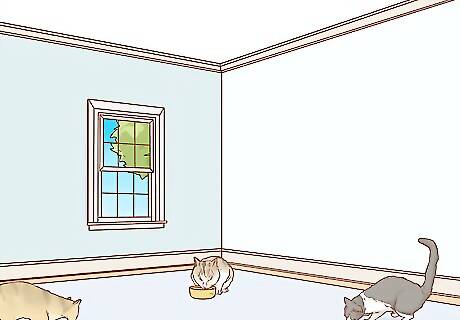
Place the cats as far away from each other as possible. When feeding cats in a multiple cat household, you need to space them away from each other. This may mean that you place food dishes in separate corners of the same room or you place feeding stations in completely separate rooms. Giving all your cats space from other cats will allow them to better focus on their food instead of turf wars or food competition. It is ideal if your cats cannot see each other during meal time. This add tremendously to your cat's ability to focus on food instead of the other cats.
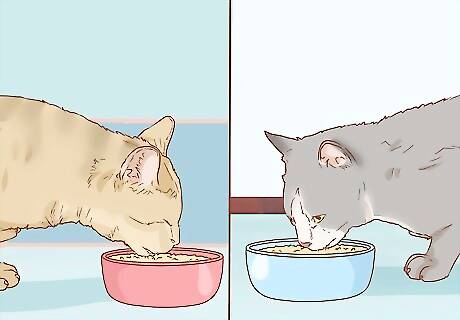
Isolate cats eating different foods. If your cats eat different food, it is important that you feed them in different spaces. This will help you to keep each cat eating the food that it is supposed to eat and it will prevent fights over whatever food your cats consider the tastiest. It may be that one of your cats eats different food and your other cats eat the same food. If this is the case, only the cat with different food needs to be isolated during meal time. Cats that are eating different food need to be kept separate until all cats in the household are done eating. The will remove the temptation to sneak a bite from the bowl of the last cat eating.
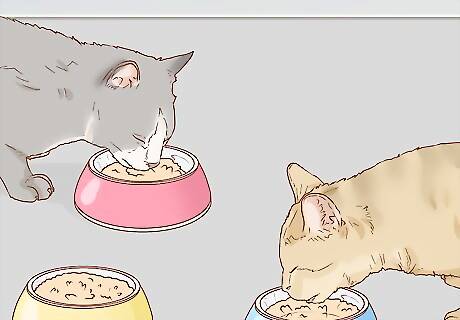
Try adding an extra feeding dish if problems persist. Adding 1 more dish than the number of cats you have can help eliminate any chances of conflict. With an extra bowl, your cats won't have a problem finding somewhere to eat in peace. For example, if you have 2 cats, you could try adding a third feeding dish. If you add an additional feeding dish, make sure you put a water dish nearby.
Avoiding Conflict
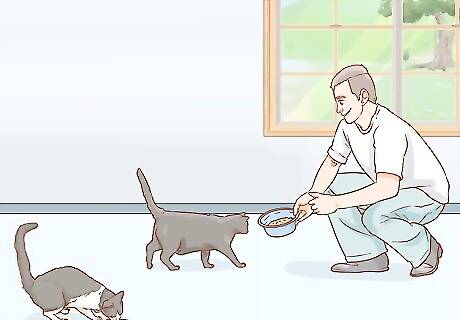
Coax cats to their own bowls. If more than one cat goes to one bowl at mealtime, you should coax the cat away who does not normally eat at that bowl. This could be done by picking the cat up, calling to it, or luring it towards its own bowl with a bit of food. This separation will prevent territorial disputes and conflict during meal time. There can be power dynamics between cats that they need to sort out themselves. When cats are initially establishing whose dish is whose, there may be some switching up that occurs.
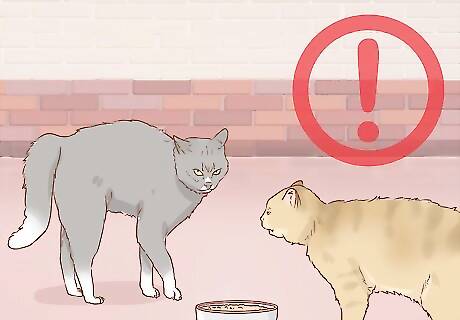
Stop fights right away. When fights break out over territory or food you should break them up right away. Fighting over food, especially between cats who usually get along, can lead to unhealthy aggression, so it should be stopped before it gets serious. If you have two cats that repeatedly fight over food dishes, these cats should be fed in different rooms.
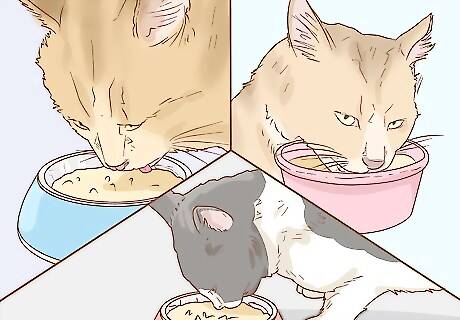
Avoid conflict before it starts. In order to have a peaceful household with multiple cats, you may need to resort to keeping certain cats away from each other most of the time, which includes meal time. This will allow you to avoid conflict before it begins and it allows both cats to have peaceful and calm time in their homes. If you have a very small home, this can be difficult to achieve. Keeping cats that don't get along separated works better if you have a large house or at least several rooms that can be closed off. You can also try feeding aggressive cats in cat carriers. That way they won't be able to run around and harass your other cats when they're finished eating. While it is true that some cats may have conflict at first and then learn to get along, that is not always the case. If you have tried to get your cats to get along and nothing seems to work, it may be time to give them separate territories in your home.




















Comments
0 comment